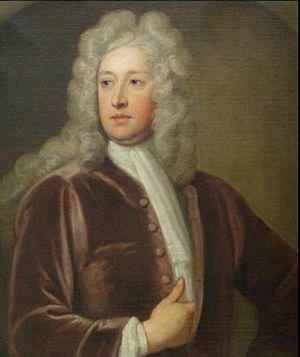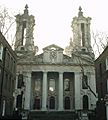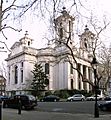Thomas Archer facts for kids
Quick facts for kids
Thomas Archer
|
|
|---|---|
 |
|
| Born | c. 1668 |
| Died | 22 May 1743 his house Whitehall
|
| Nationality | English |
| Occupation | Architect |
| Buildings | St. Paul's, Deptford St John's, Smith Square |
Thomas Archer (1668–1743) was an English Baroque architect, whose work is somewhat overshadowed by that of his contemporaries Sir John Vanbrugh and Nicholas Hawksmoor. His buildings are important as the only ones by an English Baroque architect to show evidence of study of contemporary continental, namely Italian, architecture.
Life
Archer spent his youth at Umberslade Hall in Tanworth-in-Arden in Warwickshire, the youngest son of Thomas Archer, a country gentleman, Parliamentary Colonel and Member of Parliament, and Ann Leigh, daughter of the London haberdasher, Richard Leigh. The exact date of Archer's birth is unknown, but can be inferred from the two documentary sources that mention his age. One is an entry in the Oxford University register recording his matriculation at Trinity College on 12 June 1686, aged 17; the other, his epitaph, survives in the parish church of Hale, Hampshire. If these records are accurate, he must have been born between 12 June 1668 and 22 May 1669. Thomas is the only one of the Archer children not to have his birth recorded in the Tamworth-in-Arden parish register, which suggests he may have been born elsewhere. He attended Trinity College, Oxford, from which he matriculated on 12 June 1686. After leaving university, he went on a Grand Tour, spending four years abroad and was influenced by the work of Bernini and Borromini.
Churches
Among Archer's churches was St John Evangelist, Westminster, suggestive of Hawksmoor's baroque influence. Its four towers were originally built to stabilise subsidence. Historians believed that was more likely than following Sir John Vanbrgh's style. Built in 1750, St Paul's, Deptford, sweeping semi-circular porticos were not copied for a century until Smirke's magnificent church at St Mary's, Bryanston Square that dominated the street. At St Philip's, Birmingham, now Birmingham Cathedral there was a strong sense of the Italianate Lombardic influences of High Baroque style of churches: ornate, high ceilings, with cupola and dome. External to St Philips is the roof balustrade quite unusual in English church architecture. St John's and St Paul's were both built for the Commission for Building Fifty New Churches. John Summerson said these two buildings "represent the most advanced Baroque style ever attempted in England". According to the minutes of the Commissioners, Archer also "improved" Hawksmoor's designs for St Alfege's at Greenwich, although the nature of the improvements, or whether they were implemented, is unknown.
At Hale, Hampshire, he remodelled St Mary's Church, which also contains his memorial, carved by Sir Henry Cheere to Archer's own design.
Secular works
Archer's secular works included Roehampton House in Surrey, Welford Park in Berkshire, and the Cascade House and the west front and broadly bowed pilastered north front at Chatsworth House. In 1709–11 Archer designed a Baroque garden pavilion for Henry Grey, 1st Duke of Kent at Wrest Park, Silsoe, Bedfordshire. After 1712 Archer designed Hurstbourne Priors in Hampshire for John Wallop (later Earl of Portsmouth).
He was a founding governor of the Foundling Hospital in London in 1739, but was not involved in the construction of the resulting building, completed c. 1750. The architect for that project was Theodore Jacobsen.
Documented works
- Chatsworth House, North front, Derbyshire, c. 1705
- Heythrop Hall, Oxfordshire, c. 1705
- St Philip's, Birmingham, 1708–1715
- Garden pavilion, Wrest Park, Bedfordshire, 1709–1711
- Roehampton House, Surrey, 1712
- Cliveden House, Service pavilions and the quadrant colonnades, Buckinghamshire
- Hurstbourne Priors, Hampshire, 1712
- St John’s, Smith Square, London, 1713–1728
- St. Paul's, Deptford, 1712–1730
- Hale Park, Hampshire, 1715
- St Mary’s Church, additions, Hale, Hampshire, 1717
- Harcourt House, Cavendish Square, London, 1722
- Hale Park, the house Archer designed for himself.
Attributed works
- Welford Park, remodelling of house, Berkshire, 1700
- Chicheley Hall, Buckinghamshire, c. 1703
- Parish church, chancel, Chicheley, 1708
- Addiscombe House, Croydon, Surrey, c. 1703
- Monmouth House, Soho Square, London, 1703
- Russell House, King Street, Covent Garden, London, c. 1704
- Cascade House, Chatsworth House, Derbyshire, 1705
- Hill House, Cain Hill, Wrest Park, Bedfordshire, c. 1710, demolished
- Bramham Park, Yorkshire, c. 1710
- Kingston Maurward, Dorset, 1717–1720
- Marlow Place, Buckinghamshire, 1720
- Chettle House, Dorset, c. 1730
- Monument to Susannah Thomas, Hampton Church, Middlesex, c. 1731
- Archer Memorial, St Mary’s Church, Hale, Hampshire
- Thomas Archer (his father) monument, St Mary Magdalene Church, Tanworth-in-Arden, Warwickshire
Gallery
-
Thomas Archer's garden pavilion at Wrest Park, 2007
See also
 In Spanish: Thomas Archer para niños
In Spanish: Thomas Archer para niños

















